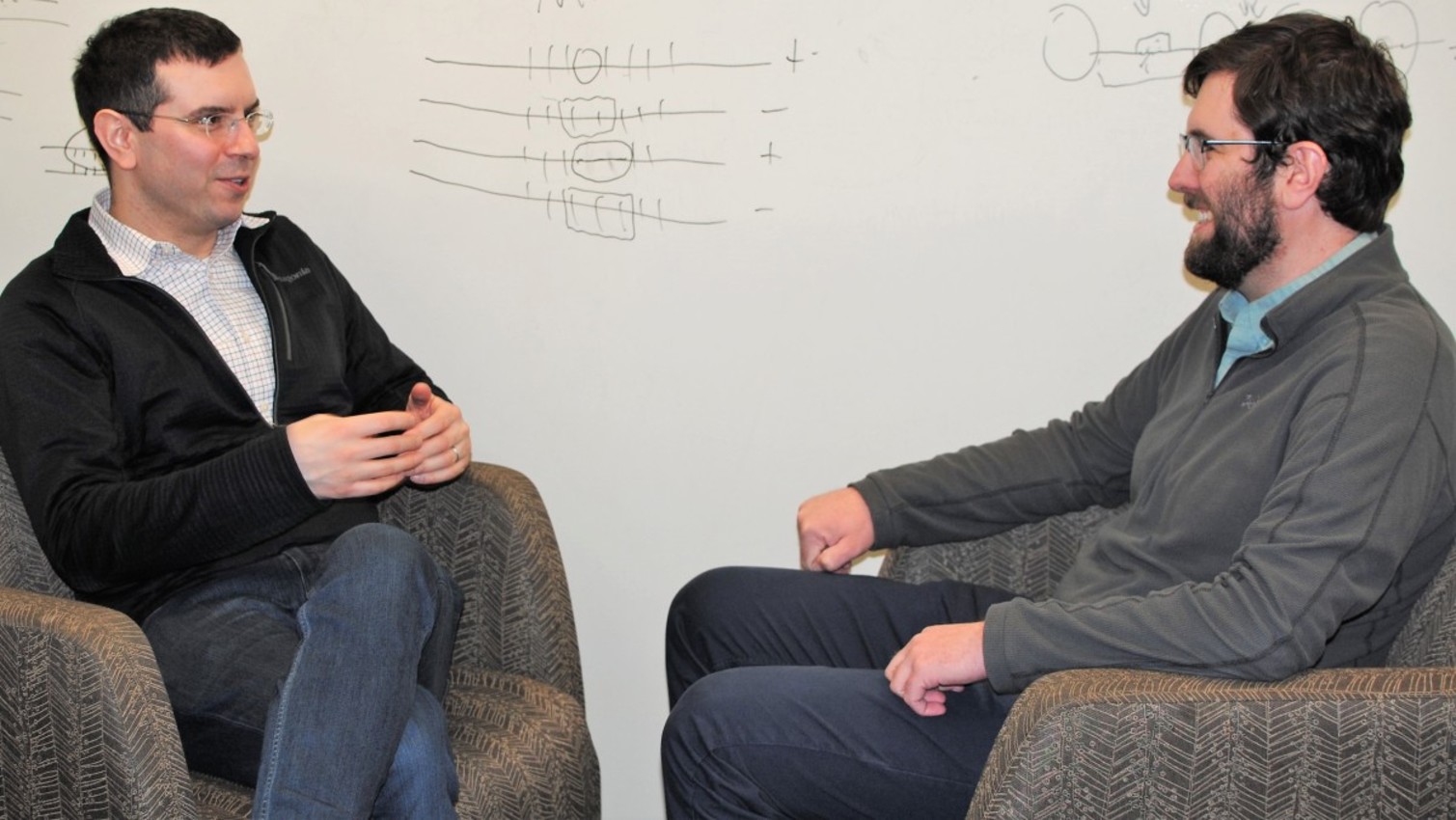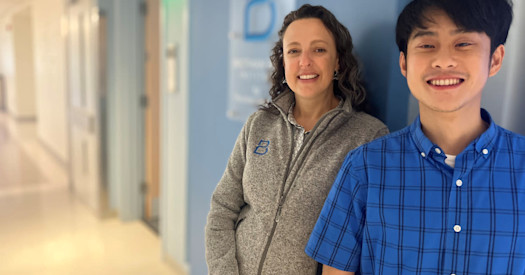 Dr. Mitchell Vollger (right) discusses computational tools with Dr. Andrew Stergachis.
Dr. Mitchell Vollger (right) discusses computational tools with Dr. Andrew Stergachis.
“Commit yourself to lifelong learning. The most valuable asset you will ever have is your mind and what you put into it.” Albert Einstein
One can imagine Dr. Mitchell Vollger sitting in a lecture hall at Zürich’s Swiss Federal Institute of Technology in 1913 and jotting down that quote from his physics professor. The phrase “lifelong learner” seems to exemplify his passion for his work in genetics, computational biology, and other related fields.
“Mitchell takes problems that may have been solved in the past in a very specific way and he takes a very different approach to deal with them in a much more efficient way,” said Dr. Evan Eichler, a professor of Genome Sciences at the University of Washington School of Medicine. “He looks at ways to solve problems that were not necessarily unsolvable, but it was not immediately clear how to solve them.”
Eichler, Vollger, and more than 90 colleagues from numerous countries last year published a series of papers on the first complete, gapless sequence of a human genome. Vollger led one of the six papers published in the journal Science, “Segmental duplications and their variation in a complete human genome.”
“He designed an approach to distinguish what was known in the past and what was (newly) added” Eichler said. “Especially in regard to the duplicated sequence. In fact, almost all the genes that were added, about 2,000 in total, were added in the duplicated regions of the genome…. His paper goes much further than that. It tried to say, ‘Well we have one reference genome, what would it be like if we had ten?’ ”
Vollger’s academic journey, unlike many other post-doctoral students in his field, did not begin at a leading university; it started at a community college, College of the Redwoods, in Eureka, California.
“Toward the middle of high school, I was eager to learn more and began taking courses at a community college to further my education,” Vollger said. “It was an excellent decision. For professors at community colleges, their primary goal is to teach.”
In 2011, after completing Associate of Arts degrees in math and science, he arrived at Princeton University, where he took one class and met one professor that both were pivotal to his future. He took a special series of courses called the “Integrated Science Curriculum.” Instead of teaching math, chemistry, physics, and computer science as independent subjects, they all were taught together as an integrated subject.
And the professor?
“Alison Gammie changed the trajectory of my career and my experience at Princeton,” Vollger said. “She knew I had experience in computer science and asked me work in her lab. During that time, she introduced me into science with patience and compassion. I was invested in STEM-related work, but pursuing a career in science seemed unattainable. Before Allison I did not think I was good enough to work in science, but she showed me how I could be successful.”
Gammie, who now serves as director of Training, Workforce Development and Diversity at the National Institute of General Medical Sciences, part of NIH, recalls Vollger with equal fondness and respect.
“I met Mitchell in 2013,” she said. “I have taught over 800 undergraduates. Mitchell stands out in my mind for his refreshing and genuine intellectual curiosity. While in my course and when completing his independent work with me, Mitchell tackled his projects and responsibilities with drive and determination.”
That drive and determination led him to complete in four years a Bachelor Science degree in Computer Science Engineering, and a Certificate in Quantitative and Computational Biology at Princeton. They also enabled him to narrow his focus on doctoral programs on the West Coast.
“I interviewed with many PhD programs, but I was excited about the UW’s Genome Sciences department,” he said. “There is an explicit focus on genomics, a field I was interested in, and when I visited I saw the interdisciplinary nature of the department. There were biologists and computer scientists working side by side, and that resonated with me.”
Vollger, now 30, arrived as a predoctoral candidate at age 23 in the lab of Dr. William Noble in the Department of Genome Sciences in the fall of 2016 and a few months later started working alongside Dr. Debbie Nickerson.
“Debbie told me at the end of my rotation that I would be a fool if I did not try to land a rotation with Evan Eichler,” Vollger said.
It proved to be a wise admonition from Nickerson, whose career was tragically cut short in December of 2021 from an aggressive form of metastatic abdominal cancer. Vollger remained in Eicher’s lab through the completion of his Ph.D. in Genome Sciences and one year as a post-doc.
In April of 2022, Vollger joined the lab of Dr. Andrew Stergachis, an assistant professor of Medical Genetics. The lab studies gene regulation and how changes in how the genome is regulated lead to disease. Vollger has developed powerful computational tools that enable the lab to study how gene regulation is occurring across the genomic regions that he played a role in mapping for the first time as part of his graduate studies.
“Mitchell is a lifelong learner and is an exceptionally talented computational biologist and software engineer,” Stergachis said. “He has taken some of the tools developed in our lab and brought them to the next level. Moreover, part of his brilliance is his willingness to work as a team player, and help others to achieve larger goals as a community. That team aspect of science will bode well for him in the future.”


